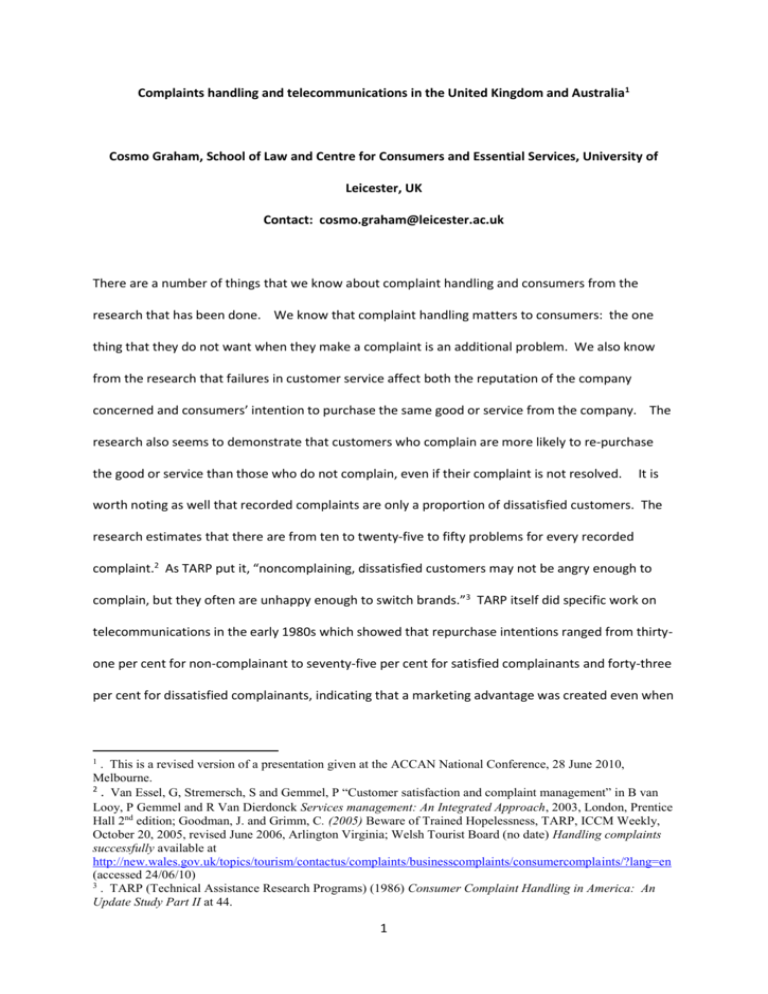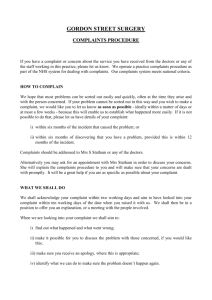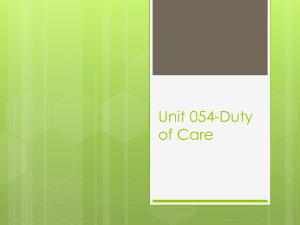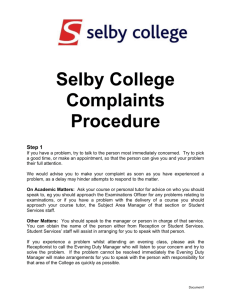Complaints handling and telecommunications in the United
advertisement

Complaints handling and telecommunications in the United Kingdom and Australia1 Cosmo Graham, School of Law and Centre for Consumers and Essential Services, University of Leicester, UK Contact: cosmo.graham@leicester.ac.uk There are a number of things that we know about complaint handling and consumers from the research that has been done. We know that complaint handling matters to consumers: the one thing that they do not want when they make a complaint is an additional problem. We also know from the research that failures in customer service affect both the reputation of the company concerned and consumers’ intention to purchase the same good or service from the company. The research also seems to demonstrate that customers who complain are more likely to re-purchase the good or service than those who do not complain, even if their complaint is not resolved. It is worth noting as well that recorded complaints are only a proportion of dissatisfied customers. The research estimates that there are from ten to twenty-five to fifty problems for every recorded complaint.2 As TARP put it, “noncomplaining, dissatisfied customers may not be angry enough to complain, but they often are unhappy enough to switch brands.”3 TARP itself did specific work on telecommunications in the early 1980s which showed that repurchase intentions ranged from thirtyone per cent for non-complainant to seventy-five per cent for satisfied complainants and forty-three per cent for dissatisfied complainants, indicating that a marketing advantage was created even when 1 . This is a revised version of a presentation given at the ACCAN National Conference, 28 June 2010, Melbourne. 2 . Van Essel, G, Stremersch, S and Gemmel, P “Customer satisfaction and complaint management” in B van Looy, P Gemmel and R Van Dierdonck Services management: An Integrated Approach, 2003, London, Prentice Hall 2nd edition; Goodman, J. and Grimm, C. (2005) Beware of Trained Hopelessness, TARP, ICCM Weekly, October 20, 2005, revised June 2006, Arlington Virginia; Welsh Tourist Board (no date) Handling complaints successfully available at http://new.wales.gov.uk/topics/tourism/contactus/complaints/businesscomplaints/consumercomplaints/?lang=en (accessed 24/06/10) 3 . TARP (Technical Assistance Research Programs) (1986) Consumer Complaint Handling in America: An Update Study Part II at 44. 1 the complaint could not be satisfactorily resolved.4 We should note as well that customers whose complaints were resolved to their satisfaction were more likely to remain with the company and purchase its products. We know as well that customers will talk about their complaint experience to their friends, relatives and neighbours and, increasingly these days, vent their frustrations on via web-sites or Facebook. So for example, there is an “I hate Telstra” group on Facebook, a “Nope Optus” group as well as Telstrasucks.com (and I do not claim that this is comprehensive). To summarise, good complaint handling can make it more likely that you retain your customers and bad complaint handling also has reputational effects on the brand, as well as losing customers. In addition, the data from complaints can be used as a source of information to improve a business by showing where problems are occurring and what customers think is important. This point is seen in the ISO standards, as well as in academic work.5 (Johnston (2001: 61) and see also Johnston and Mehra 2002). These points are, in general, well understood and not controversial. What is striking about the telecommunications industry in Australia, is the extraordinarily high number of complaints received by the Telecommunications Industry Ombudsman over the last few years (see Table 1). Table 16 Year 2006-07 2007-08 2008-09 09 (2nd half) Complaints 102,463 149,742 230,065 115,531 4 . Ibid. Although this study could only have been done at the earliest stages of a competitive long distance telecommunications market. 5 . Johnston, R. (2001) “Linking complaint management to profit” International Journal of Service Industry management, 12, 60-69; Johnston, R. and Mehra, S (2002) “Best-practice complaint management” Academy of Management Executive, 16, No 4, 145-154. 6 . Source TIO Annual reports and personal communication. 2 We can compare this to the UK’s experience, bearing in mind that the UK population is about three times greater than that of Australia and the market is worth about twice as much, on OECD statistics for 2007 (Table 2). Table 27 Year 2005-06 2006-07 2007-08 2008-09 2009-10 Complaints (Otelo and Cisas) 5,734 5,609 5,789 8,887 Complaints (Phonepay Plus) 19,591 9,435 10,463 23,244 11,249 There are a number of issues in relation to the comparability of this data but, even taking this into account, the difference is striking. On the worst interpretation of the UK figures, there are around seven times as many complaints in Australia about telecommunications services as in the UK in 2008-09. On the best interpretation, there are around twenty-five times as many complaints in Australia. This difference cannot be explained by saying that the UK telecommunications companies are better at handling complaints, as the UK regulator, Ofcom, is not happy about complaint handling by telecommunications companies.8 The absolute level of complaints recorded in the Australian telecommunications industry is, in my experience, quite extraordinary. The only body dealing with private sector complaints in the UK which comes near is the Financial Ombudsman Service, which covers most of the financial services sector in the UK and had a record 127,421 new cases in the year 2008-09, again, less than the TIO.9 The Financial Services Authority, the industry regulator, lays down rules about record keeping for 7 . Source: Otelo, Cisas and Phonepay Plus Annual Reports. Complaint handling in the UK is split between three organisations. Otelo (Office of the Telecommunications Ombudsman) and Cisas (Communication and Internet Services Adjudication Scheme) cover complaints against public communications providers, who may belong to either scheme. Phonepay Plus covers premium rate products and services and its jurisdiction extends beyond public communications providers. 8 . See Ofcom A Review of Consumer Complaints Procedures (2009). 9 . The data here and later in the paragraph is taken from Financial Ombudsman Service Annual Review 200809 and http://www.financial-ombudsman.org.uk/publications/complaints-data.html (accessed 27/07/10) 3 financial services companies and these indicate that there are around three million complaints recorded for the last three years, of which about two million per annum relate to complaints about banks. This converts to a ratio of 22 complaints at company level for every one ombudsman complaint. If this were the case in the Australian telecommunications industry, it would suggest 5 million company complaints in 2008-09, about one in four of the Australian population. Having said this, there does seem to be a wider issue here about complaint handling and customer service in relation to telecommunications as an industry. Work a few years ago by IPSOS-Mori for Ernst & Young found that consumer satisfaction with the handling of complaints by UK telecommunications companies was worse than that of retailers, bank and other utilities.10 Of this, perhaps the most surprising is the finding in relation to the banks – which are not renowned for customer service in the UK. Ofcom’s own work has found that telecommunications companies do not handle complaints well and is currently considering changes to the UK regulatory framework. Both the TIO and Otelo (the UK equivalent ) have been concerned with the telecommunications companies approach to complaint handling and customer service. As Otelo put it: “it is disappointing that despite [customer service] appearing in every annual report we have produced to date, it remains a real problem for the sector.”11 Similarly, the TIO has said, “The proportion of customer service related complaints remains unacceptably high, and in the TIO’s view, the industry still has much work to do in this area.”12 So, there is a problem. What can we do about it? We can divide complaint handling systems into those internal to an organisation and those external to it. I am going to focus more on internal 10 . See Ofcom, above, n 7 at paras 4.48-4.49. . Otelo Annual Report 2009 at 13. This was still the highest category of complaints for Otelo in the 2010 report: Oteleo Annual Report 2010 at 4. 12 . TIO Annual Report 2009 at 26. 11 4 systems because I suspect that this is where the problem lies. An external complaint handler, like TIO or Otelo, is just the recipient of complaints that are not resolved at the first level. We start with setting out some basic principles that internal systems ought to adhere to. This is based on work that I have done in the UK with a colleague but they should be familiar to everyone as there is widespread agreement on the underlying principles, which are reflected in, among other things, industry standards of best practice. I have organised them as five points: • Accessibility • Effectiveness • Fairness and consistency • Responsiveness • Organisational ownership and commitment One important introductory point: the devil is in the detail. I mean this in two senses: we can all agree at a high level on the general principles that inform good complaint handling. We may, however, not agree on how to implement these principles. For example, Ofcom is still arguing with the industry about adopting a common definition of complaints in the UK, unlike in Australia. Secondly, there is often a gap between the top of an organisation and the front line where good intentions do not get translated into action – a fairly common failing of large organisations. Let us have a look at these in some more detail, with some reflection on where things might be going wrong. Accessibility encompasses a number of dimensions. These days you assume that everyone allows you to make a complaint via their web-site or at least provides the information on how to do so on the web-site. Some make it easier than others. Before doing this presentation, [I did my usual thing of checking on a couple of web-sites. For Telstra, make a complaint is right on the front page of their 5 site. For Optus, I couldn’t find out how to make a complaint, within a short space of time. I could find it for BT and British Gas, although neither had them on the front page – and BT’s promise to explain how they handled complaints didn’t work!] Whether the information is clear is another matter. Providers tend to make it easy to submit complaints by not specifying what you have to provide, ie, by just providing a blank form to fill in. Finding out information about how the complaints process is actually going to work, and what you can expect in terms of responses, can be more difficult. This links into the effectiveness question, in particular the ability of staff to respond to a complaint. This is a very common problem with complaint handling systems in telecommunications in that people feel that they are pushed around an organisation, as opposed to getting one person who can deal with their query. This experience suggests that organisational learning is not working. Everyone would accept that an important part of fairness is objectivity and listening to the complaint. . The listening side is anecdotally often a problem: staff do not listen to the complaint but assign it to pre-planned boxes/categories in their heads. Responsiveness does seem to be an important problem, especially in the UK. Here Ofcom reckoned that 30% of telecoms complaints were unresolved within 12 weeks, which they estimated worked out as 3 million complaints a year where the complaint was unresolved after 12 weeks .13 The time limits that are set in Australia are tighter and this does not seem to be a major source of problems. According to the TIO, the two biggest problems in terms of complaint handling are the failure to do what was promised (“action undertakings”) and the failure to escalate to the TIO (that will be worrying). The former is also a large part of the customer service complaints, as well as the giving of incorrect information. 13 . Ofcom above n 7 at para 4.19. 6 Finally, there is organisational ownership and commitment. This was a point that was made to me by the Local Government Ombudsman in the UK – that you could not improve complaint handling in an organisation unless those at the top bought into the idea of effective complaint handling. When I did the first research into the Insurance Ombudsman in the early 1990s, I also tracked company complaint handling systems. For large insurance companies, these were typically run by a woman who “did” complaints, that office was not part of the general business structure. At this point, there was not organisational buy-in. It is worth emphasising again, that organisational buy-in requires more than those at the top of the organisation accepting the principles of good complaint handling, no matter how sincerely. This is a necessary first step but then the principles have to become part of the organisational culture and be implemented on the ground. In terms of external systems, the following principles are generally agreed: • Accessibility • Consumer support • Fairness • Effectiveness • Redress • Independence • Accountability The UK system is not a great model to hold up to the world. First, we have two complaint handling bodies: Otelo and Cisas, who split the industry between them. Consumers have never heard of either of these two bodies. Ofcom research found that consumer awareness of these two bodies was eight per cent for their entire sample and only fifteen per cent for those who had complained to a telecommunications company.14 Although I have not seen any data, I suspect that the TIO in 14 . Ofcom above n 7 at para 4.42. 7 Australia has a much higher recognition factor, if only because of the number of complaints that it handles and the high public profile of the issue. Because there are two bodies in the UK, they spend some time turning people away because they are in the wrong place. For example, about 3,800 contacts for Otelo in 2009 were turned away because the company was not a member of Otelo, about 9% of total contacts. Around 72% of total contacts in2009 could not be accepted for investigation because, although they related to a member company, they were outside Otelo’s jurisdiction, typically because the complainant had contacted them too early in the process. 15 Another point to notice is that, although both Otelo and Cisas are quite open about their own operations, they do not publish the sort of company complaints data that the TIO does. Nor has there been equivalent of the connect.resolve campaign in the UK. Conclusions The Australian figures and experience present a puzzle to me. If you look at the rules and arrangements which are meant to govern complaint handling, they look pretty good, in terms of substance as well as procedure. However, the recent record looks very poor, even when compared to the UK which is not a beacon of good practice in this area and this raises the question as to whether what has been agreed is actually being implemented. This looks like an example of the industry failing to meet the expectations of its customers. When you get failure on this scale, this is likely to call into question the effectiveness of the regulatory arrangements, particularly when they are based on self-regulation. Indeed, since this presentation was given, ACMA has announced the terms of reference for its inquiry into customer service and complaints handling in the Australian telecommunications industry, as well as publishing a consultation paper.16 The issue may, as well, be high profile enough to feature in the election campaign. Solving problems for customers is not, however, a matter of the headlines – it does require detailed work and cultural and organisational change within the telecommunications companies. 15 16 . Otelo Annual Report 2009 at 21. The same pattern holds true in 2010: Oteleo Annual Report 2010 at 3. . See http://www.acma.gov.au/WEB/STANDARD/pc=PC_312222 (accessed 28/07/10). 8




